Packing, bathing, miracles and crisis at the Malvern ‘Water Cure’
- 17th June 2020
We are fortunate to live at a time when scientific understanding, technology and powerful medicines are available alongside an incredibly dedicated National Health Service saving countless lives against deadly disease every day. In the early 19th century, however, the link between what causes disease and Germ theory had yet to be established. Cholera, Typhoid and Tuberculosis were ravaging Britain. The prevailing opinion at the time was that ‘Miasma’ – a bad smell or atmosphere was a cause of catching disease. As the Berrow’s Worcester Journal reported in 1832 “Malvern is at present extremely full. The Alarm of cholera in different parts of the kingdom has induced many persons to take lodgings in this healthy and beautiful village”. With traditional medicine at the time seemingly unable to tackle these terrible diseases, it is unsurprising that patients sought out alternative treatments and one of those was the ‘Water Cure’ at Malvern.
Thanks to our Palfrey collection we can gain some insight into the establishment, application and effects of ‘The Cure’ on those that received it at Malvern. The waters at Malvern were first analysed by Dr. John Wall in his treatise ‘Experiments and Observations on the Malvern Waters’ available at LP 615.853 (a founding physician of the Worcester Royal Infirmary) who analysed the Holy Well and Chalybeate springs in 1756, comparing them with the Pouhon spring in Belgian Spa, Bath, Cheltenham, Bristol’s Hot Well and the purest spring in Worcester.
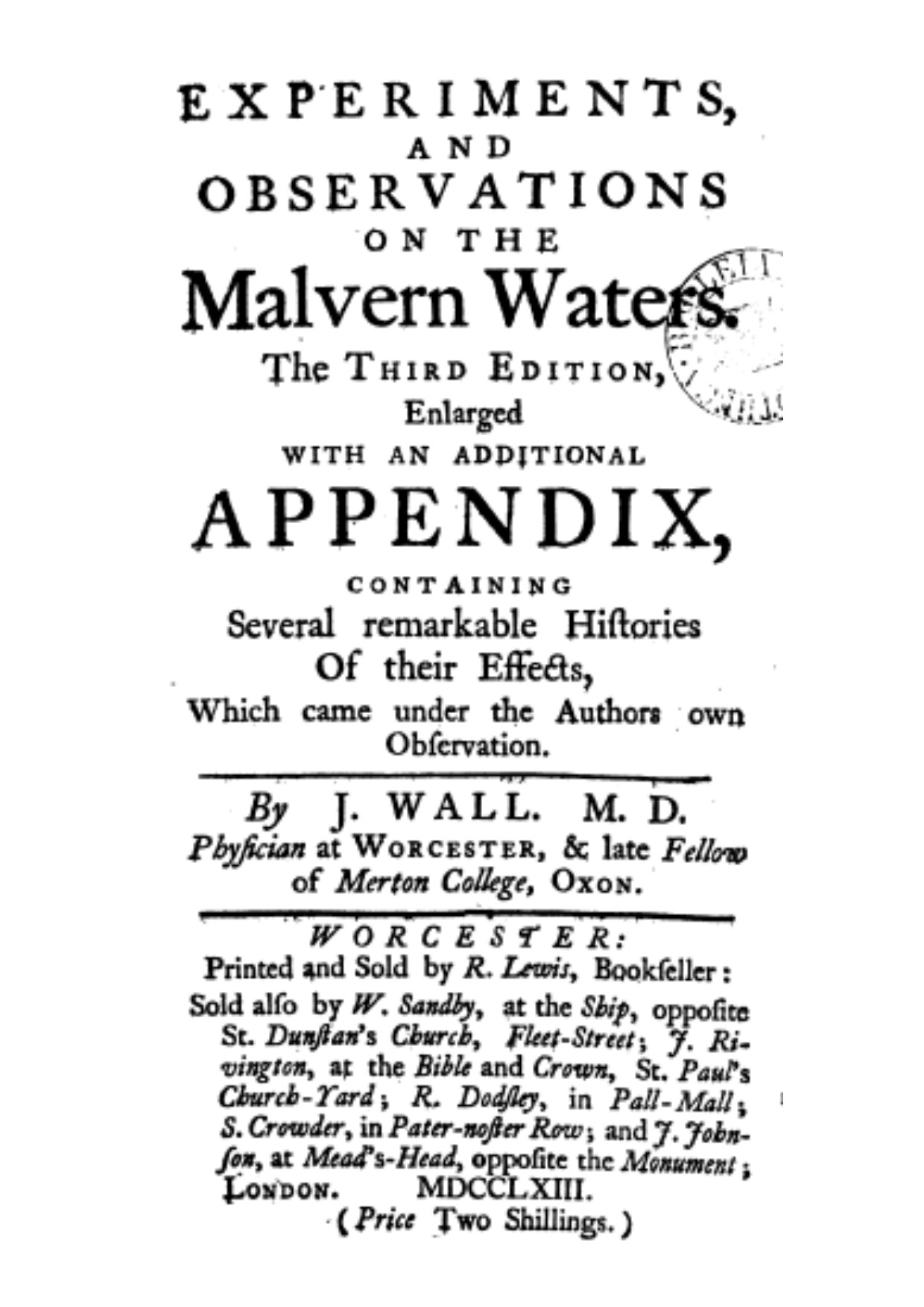
He found ‘The Waters’ contained “the least amount of dissolved matter’’ and as the saying at the time went ‘The Malvern water, says Dr. John Wall, Is famous for containing just nothing at all.’
Dr. Wall also describes the main locations of the waters:
“The Source of one is about a Quarter of a Mile below the Village of Great Malvern: This is a light and very pleasant Chalybeat. The other rises higher up the Hill, about the midway betwixt Great and Little Malvern, and has long distinguished by the name of the Holy Well”
In the appendix of the 3rd Edition, Dr Wall describes “Several remarkable Histories” of those who had been treated by the waters and “Of their Effects Which came under the Authors own Observation”. The most remarkable example ever described was
“A young Woman, Daughter of a Tradesman in Bewdley, had long had a Schrophulous Op’thfhalmy in each Eye, which made her’ unable to bear the Light. She had been in this miserable Condition eight or nine Months; and though She had applied to several Persons of Skill, had not met with any permanent relief. I advis’d Her at length to try Malvern Water. — When She was brought to the Well, She could not open her Eyes, but was forced to be led by another Person ; but she had not used the Waters more than a Week, before she was so much recover’d that she could see a Flea leaping on her Bed. Her Eyes have continued perfectly clear, and her Sight good, ever since.” (Wall, 1763)
With the notoriety of the ‘Malvern Waters’ already established, fast forward nearly 100 years as Dr. James Wilson and Dr. James Gully arrive in Malvern, appalled by orthodox medicine looking to hydropathy and a more holistic approach to restoring health. There is much evidence in the early 19th century that Doctors based treatments on centuries old ideas and involved the use of dangerous drugs and chemicals such as mercurous chloride. Wilson wrote that “Many of the incurables I have seen owed their forlorn state to little else than mercury, quinine, arsenic and purgatives.” (Harcup, 1992) Treatments such as bloodletting (by means of cupping or applying leeches) for pneumonia was commonplace (a treatment based on the Millenia-old ‘Theory of the Four Humours’ of blood, phlegm, black bile and yellow bile and a belief that an imbalance of any one of these could lead to illness) and wasn’t really challenged as a practise until the mid-19th century.
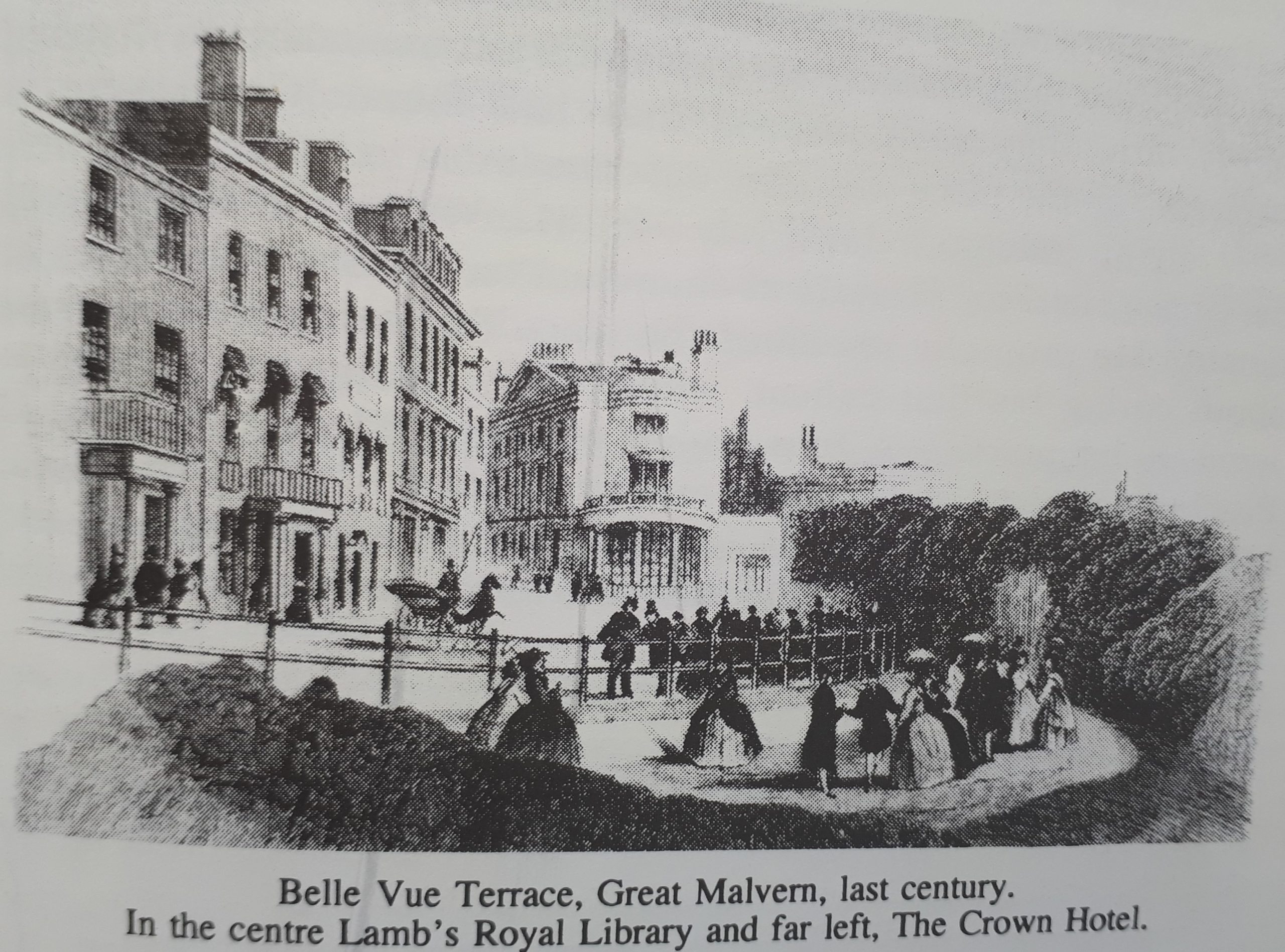
Bell Vue Terrace, Great Malvern, 19th cent. showing the Crown Hotel on the left in John W. Harcup’s The Malvern Water Cure, 1992
Dr. Wilson had visited Graefenberg in Silesia to observe Vincent Priessnitz who had formulated a new water curative regime. During 8 month’s stay, Wilson took 500 cold baths, drank 3,500 tumblers of water and spent 480 hours in cold wet sheets. On his return, he wrote to James Gully and they agreed to set up a SPA in England similar to that established by Priessnitz which required hills, curative springs and fresh mountain air. It was clear Malvern was “Graefenberg in England” (Harcup, 1992). Indeed the 1887 Baedeker‘s guide describes Malvern as “an inland health resort, famous for its bracing air and pleasant situation” and “a great educational centre”.
In 1842, Wilson and Gully Leased the Crown Hotel on Belle Vue Terrace, Malvern. It was renamed ‘Graefenberg House’ (Gully had his own establishment at Holyrood House in Wells Road) and they set about curing their first patient, a gout-ridden 64 year old local carter, named Probert who was “nearly jaundiced, breathing asthmatic” and “in less than ten days, walking well and rosy red….”. This dramatic recovery sealed Wilson’s and Hydropathy’s popularity and whilst three deaths were reported in the first year (and seized upon by critics) these patients had already had serious diseases which had failed to be cured by orthodox medicine (Harcup, 1992).
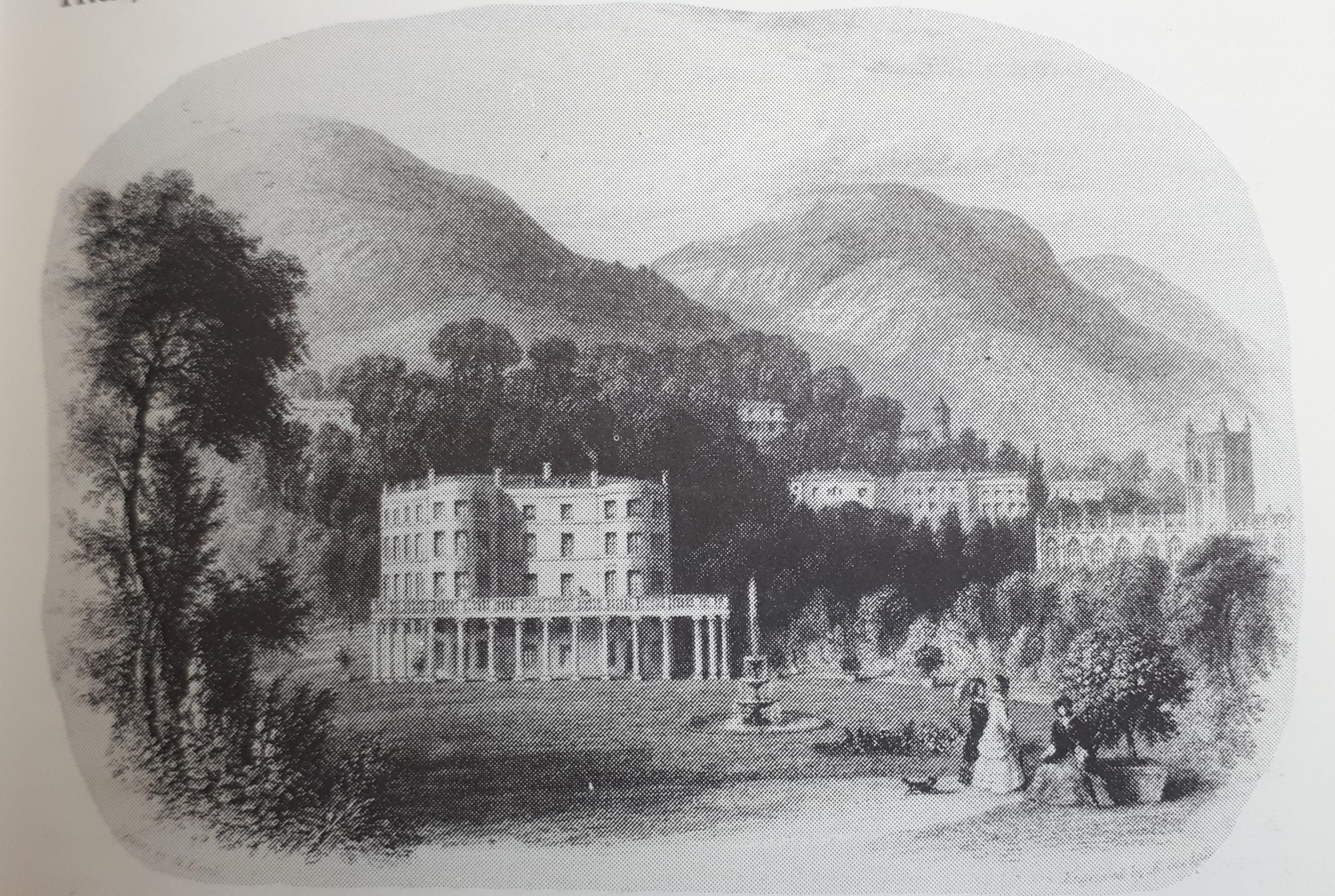
Dr Wilson’s new Hydropathic Establishment as viewed from the grounds with Priory Church to the right in John W. Harcup’s The Malvern Water Cure, 1992.
News of the ‘The Cure’ quickly spread and between the 1840’s – 1850’s prominent writers, thinkers, politicians and churchmen including Thomas Carlyle, Henry Hallam, Alfred Tennyson, Florence Nightingale, Charles Dickens, Bishop Samuel Wilberforce, William Gladstone and Charles Darwin all came to be treated (Keynes, 2001). It was unclear how many visited but soon Wilson’s ‘Graefenberg House’ became inadequate and he was forced to build the first purpose-built Water Cure facility in the whole of Britain called ‘Priessnitz House’ situated on Abbey Road, opposite the Hay Well costing nearly £20,000 containing ’72 rooms, a 90 foot dining room, a 70 foot drawing room and gymnasium for the application of Swedish Medical Gymnastics’ (Harcup, 1992).
Within a year of being in Malvern, Wilson and Gully had published about the ‘The Dangers of the Water Cure in 1843, mainly to deter the proponents of orthodox medicine, in particular the highly influential and nationally known Worcester-based Dr. Charles Hastings M.D. and as Editor of The Provincial Medical and Surgical Journal (renamed The Lancet) had ridiculed the new ‘Cure’.
As John Windsor Harcup writes in ‘The Malvern Water Cure’ Wilson and Gully listed a series of 35 propositions as the rationale in their publication behind ‘The Cold Water Cure’. Disease was said to be the violent effort of internal organs “casting their ‘mischief’ onto external and less important organs” and postulated that recovery was bought about by stimulating the nervous system to alter the circulation of the blood and thus relieve the congestion in the tissues. the whole basis of treatment was summarised in a single proposition: –
“XXIV PURE WATER, PURE AIR, PROPER DIET, AND REGULATED EXERCISE, ARE THE GREAT AGENTS IN EFFECTING THE CURE OF DISEASE BY AIDING THE NATURAL EFFORTS OF THE BODY, THROUGH THE INSTRUMENTALITY OF THE NERVOUS SYSTEM”
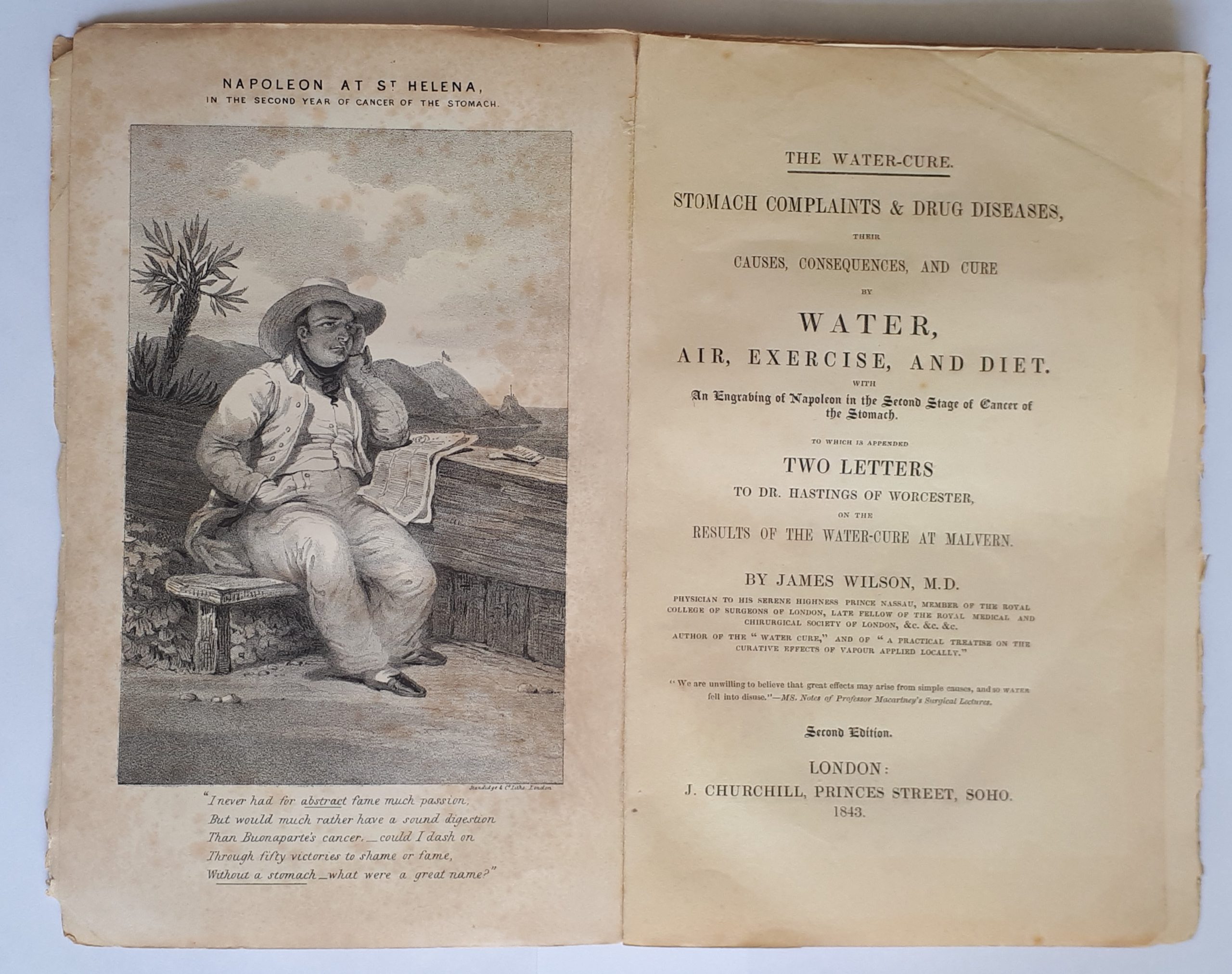
The Water Cure, Stomach Complaints & Drug Diseases by James Wilson M.D. 1843 at Ref: LP 615.853
In ‘The Water Cure, Stomach Complaints and Drug Diseases’ held in our Palfrey collection at LP 615.853 Dr. Wilson not only writes about the causes of stomach and bowel diseases, and how they and what he calls ‘Drug Diseases’ ‘may be both prevented and radically cured by the operation of water’ but gives clear examples from learned colleagues about the effectiveness of ‘The Cure’ and appends his book with an open letter to Dr. Charles Hastings in retaliation saying ‘Further as by the grace of your pen, I am written down “the hero of the water-cure”, another proud title to me, – common justice obliges me to look you as the “hero of the drug system”…
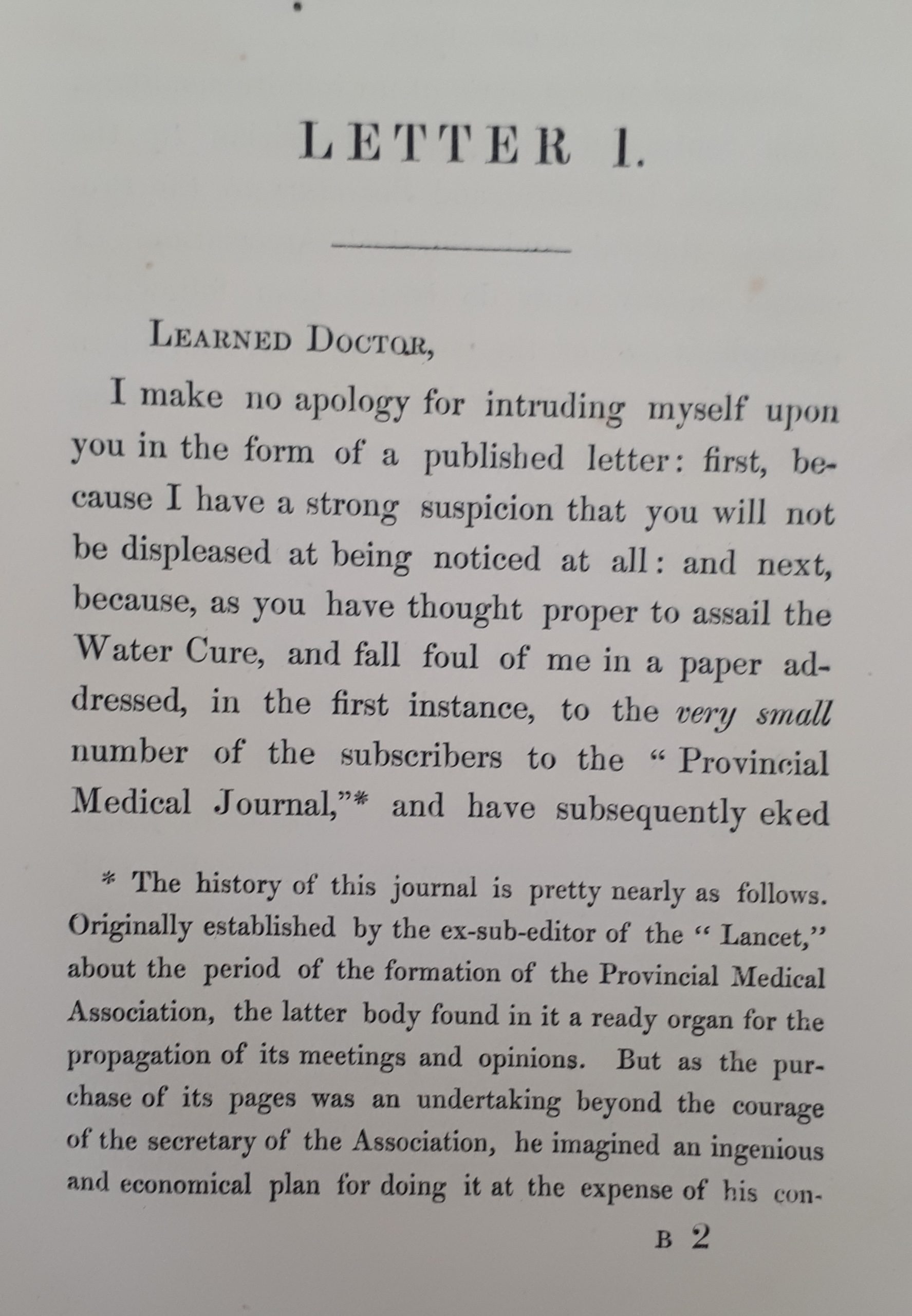
One of two open letters to Dr. Hastings by Dr. Wilson in The Water Cure, Stomach Complaints & Drug Diseases, 1843 at Ref: LP 615.853
He goes on to say “…it occurs to me as possible that M.D. may in your case stand for “Man of Drugs”. Again the facetious editor of the “Lancet” has changed the name of the Association, of which you sign yourself secretary, into that of the “Guzzling Association,” from the circumstance, I presume, of the members annually to eat dinners together for an entire fortnight” finishing with ‘I was puzzled at first to guess what the F.G.S…could possibly mean; I now perceive that it must plainly stand for “FELLOW OF THE GUZZLING SOCIETY.”(Wilson, 1843)
It was clear that battle lines had been drawn between traditional medicine and those of ‘The Cure’ with orthodox practitioners unhappy about the fame (and fortune!) it was clearly receiving.
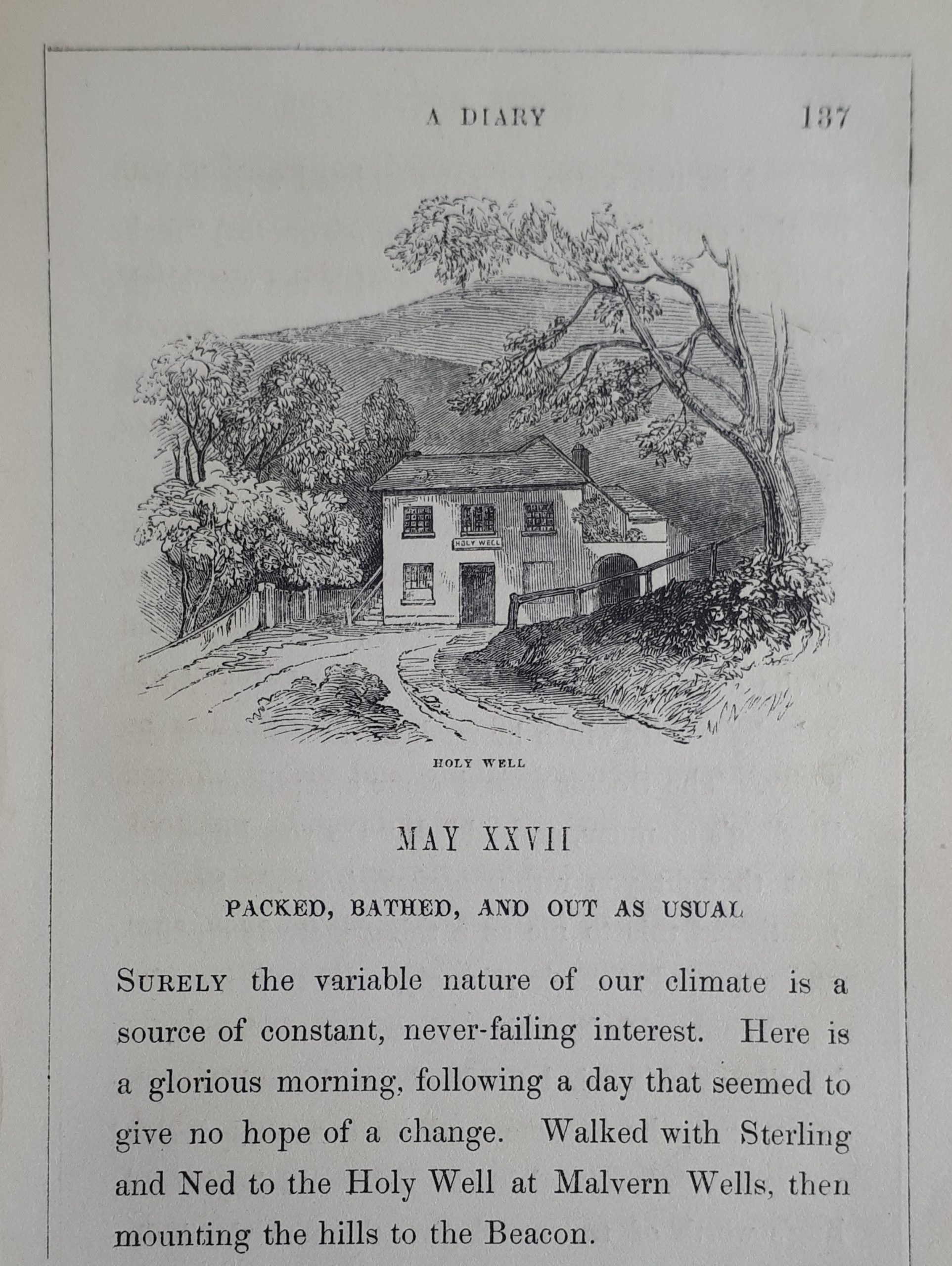
The Holy Well illustrated in R.J. Lane’s ‘Life at The Water Cure’ 1846 at Ref: LP 615.853
Prior to treatment for ‘The Cure’ each patient underwent an examination where a diagnosis was made and treatment regime provided which invariably included the number of glasses of water to be drunk, cold compresses (such as the abdominal compress otherwise called Neptune’s Girdle, or local compresses, where a wet sheet, frequently soaked with cold water, was wrapped around the abdomen or other areas and covered with a mackintosh cloth to protect the outer clothing) type of baths taken each day and confirming when the patient was fit enough to take The Douche.
The Douche also known as ‘The Great Bath at Noon’ was the climax of ‘The Cure’ and involved an immense immersion of a hundred and fifty gallons (454 litres) of cold water onto the naked body of the patient for up to 8 minutes. Other treatments include The Bath Spitz, foot and head baths and The Lamp-Bath to induce sweating.
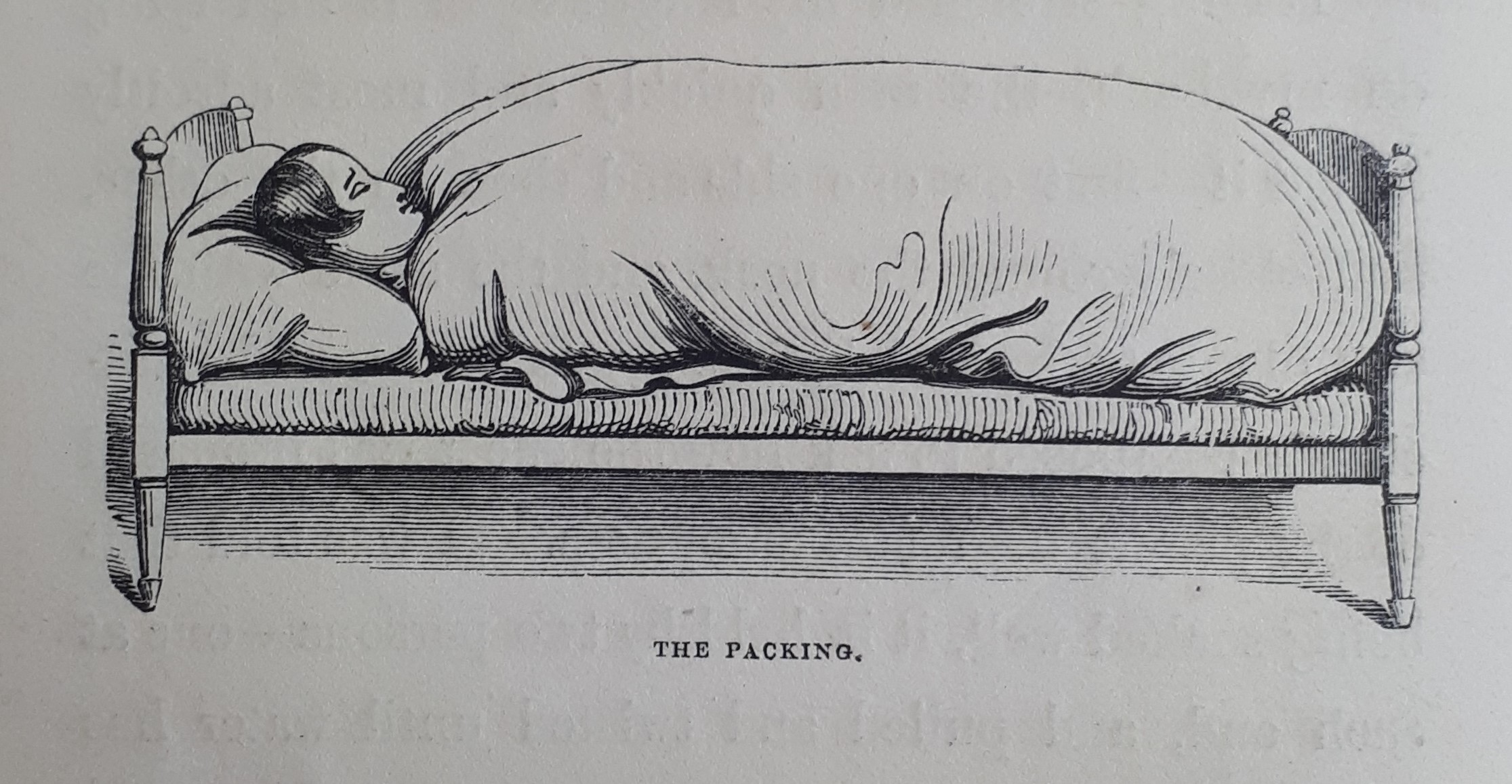
The ‘Packing’ treatment as illustrated in R.J. Lane’s ‘Life at The Water Cure’ 1846 at Ref: LP 615.853
In many cases treatment began with wet ‘Packing’ at the start of the day, followed by The Shallow Bath (which involved sitting naked in 12 inches of water with ‘the chill taken off’ following a “friction rub” of the body using a rough towel) (Harcup, 1992). The Shallow Bath, and ‘Packing’ are pictured in R.J. Lane’s ‘Life at the Water Cure’ at LP 615.853 in our Palfrey collection (Lane was Lithographer to Queen Victoria) who writes a florid and somewhat sentimental account (though detailed with wonderful engravings) of his time being treated with ‘The Cure’ Malvern.
Below is an extract of his diary of May 31st 1846, which describes his daily routine and experiences:
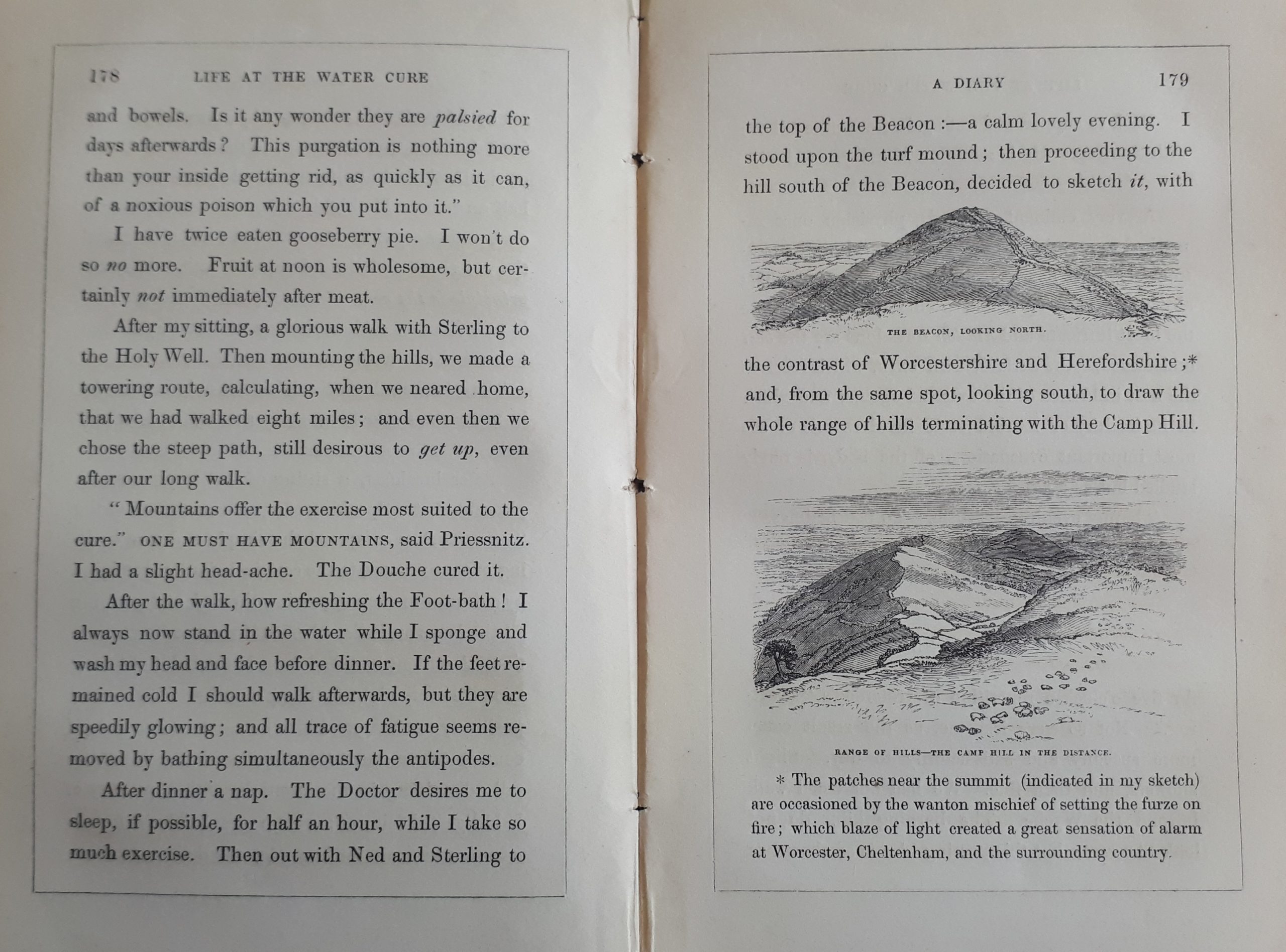
An extract from 31st May 1846 from R.J. Lane’s ‘Life at The Water Cure’ 1846 at Ref: LP 615.853
Lane was clearly a fan and proponent of Wilson and his cure as he writes in his preface:
‘and while those who sound the alarm—who “Pervert pure Nature’s healthful rules,” still refuse to give any attention to the simple and rational principles upon which Hydropathy is securely based, it calls upon the patients to form a LEAGUE, whose movement shall be irresistible’.
After months of treatment, he returned to London and continued to undertake his own Hydropathic treatments, including baths, showers and packings at his Doctor’s request and is recorded in ‘The Sequel’ appended to his diary. Like many patients, Lane experiences a so-called ‘Crisis’ that involved some bodily reaction to treatment such as boils, redness or excessive sweating. ‘I had for two days experienced a ‘critical’ result, much to be desired at the Water Cure, and which Dr. Wilson had been anxious to produce’ apparently a measure of success that the cure was working.
In his Postscript he thanks Dr. Wilson and purports to have used the cure on his children: ‘I proceed with confidence, confirmed by habit and experience; freed from the slavery of purgatives and tonics, and having attained that moral courage which has warranted me in practising, in a small way, upon two of my children, with the happiest result in both cases’ (Lane, 1846)
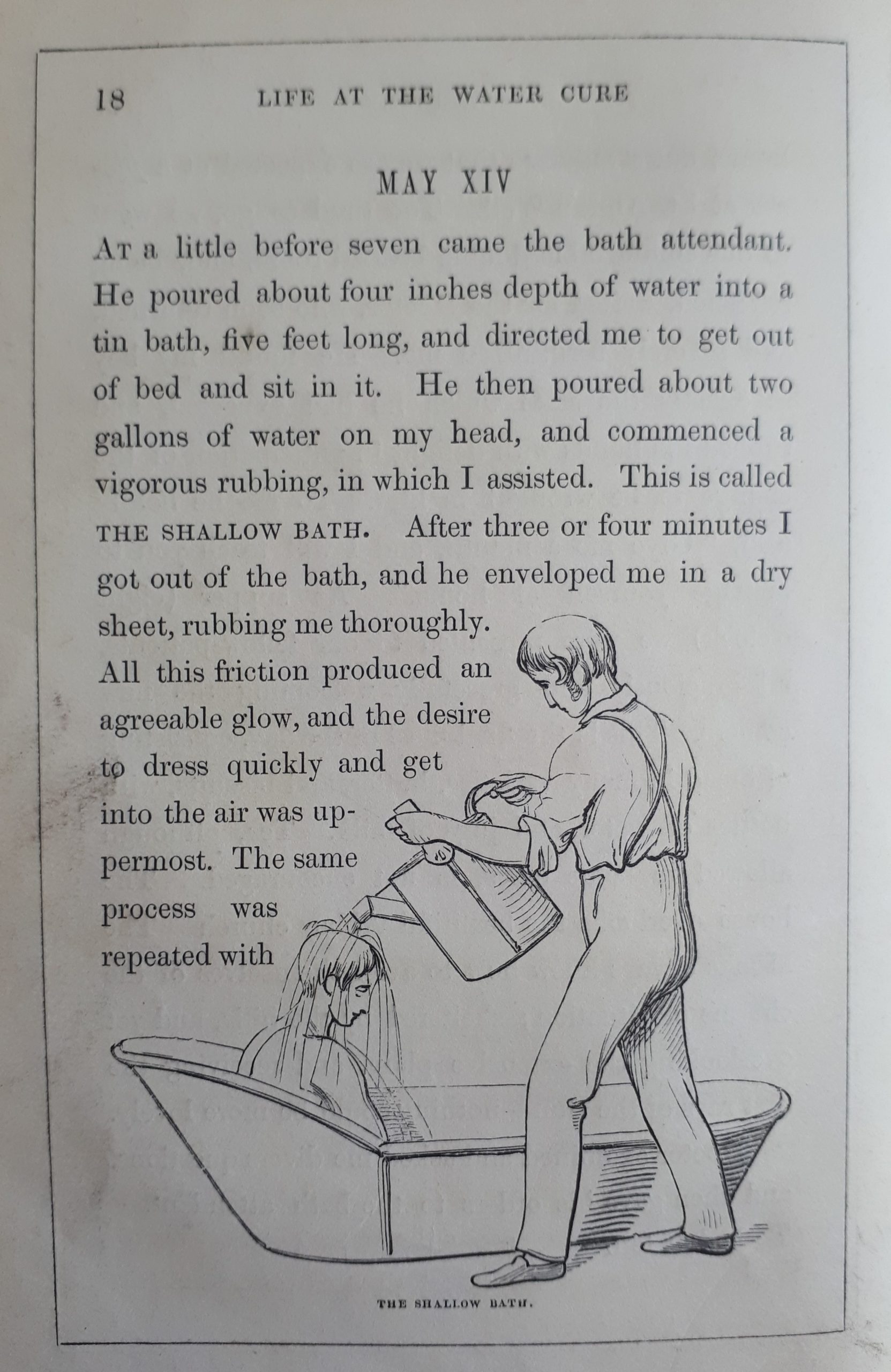
The Shallow Bath treatment as illustrated in R.J. Lane’s ‘Life at The Water Cure’ 1846 at Ref: LP 615.853
The partnership between Wilson and Gully sadly did not last. Whether this was due to their personalities or differing approaches to the cure is unclear, though criticisms of Wilson made by Gully in his book ‘The Water Cure in Chronic Disease’ (a bestseller in America!) and a quarrel over access to the Chalybeate spring (in today’s Priory Park) created a rift between them lasting until Wilson’s death (where Gully sought to make amends in his obituary). Gully retired in 1872 and an outbreak of three cases of Typhoid fever due to contaminated water at The Malvern Hydropathic Establishment or The Hydro sufficiently sensationalised by the media with several deaths sadly was the beginning of the end for the ‘Water Cure’ at Malvern. (Harcup, 1992)
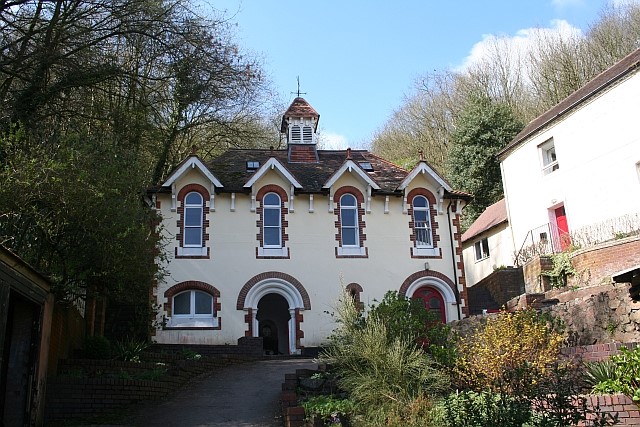
The Holy Well at Malvern Wells, Present Day, Bob Embleton, 2007. CC BY-SA 2.0
As a student studying Medicine Through Time, I learnt how vital the battle to understand the cause of infectious disease was to improvements in public health thanks to advances in microbiology made by Robert Koch and Louis Pasteur. The ‘Water Cure’ attempted to tackle diseases without any known cure at the time, alongside common illnesses. Whilst undoubtedly some of the methods of ‘The Cure’ can be called into question, against the backdrop of dangerous and unscientific approaches in traditional medicine it recognised the importance of close observation, the role of diet and physical and mental well-being in improving patients’ lives alongside personalised treatment.
Anthony Roach

The Malvern Hills from the East in R.J.Lane’s ‘Life at The Water Cure’ 1846 at LP 615.853
Further Information
Experiments and observations on the Malvern waters, 3rd. ed. enlarged with an additional appendix containing several remarkable histories of their effects..
Author: Wall, John. 1763. Available at Level 2: Palfrey Collection – 615.853
The Malvern water cure : victims for weeks in wet sheets. Author: Harcup, John W. 1992. Available at Level 2 Local Lending – 615.853
Life at the water cure : or a month at Malvern : a diary to which is added the sequel.
Author: Lane, R. J. 1846 Available at Level 2: Palfrey Collection – 615.853
The water-cure : stomach complaints & drug diseases, their causes, consequences and cure by water, air exercise and diet…to which is appended two letters to Dr. Hastings of Worcester, on the results of the water-cure at Malvern.
Author: Wilson, James 1843 – Available at Level 2: Palfrey Collection – LP 615.853
Annie’s Box, Annie’s box : Charles Darwin, his daughter and human evolution
Author: Keynes, Randal. 2001. – Available at Malvern Library, Local Reference – B DARWIN,C
Post a Comment